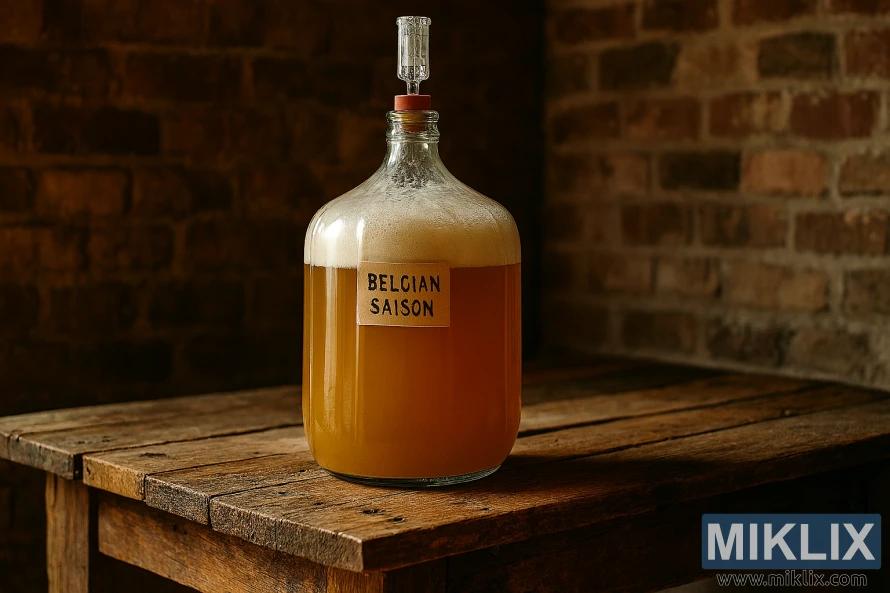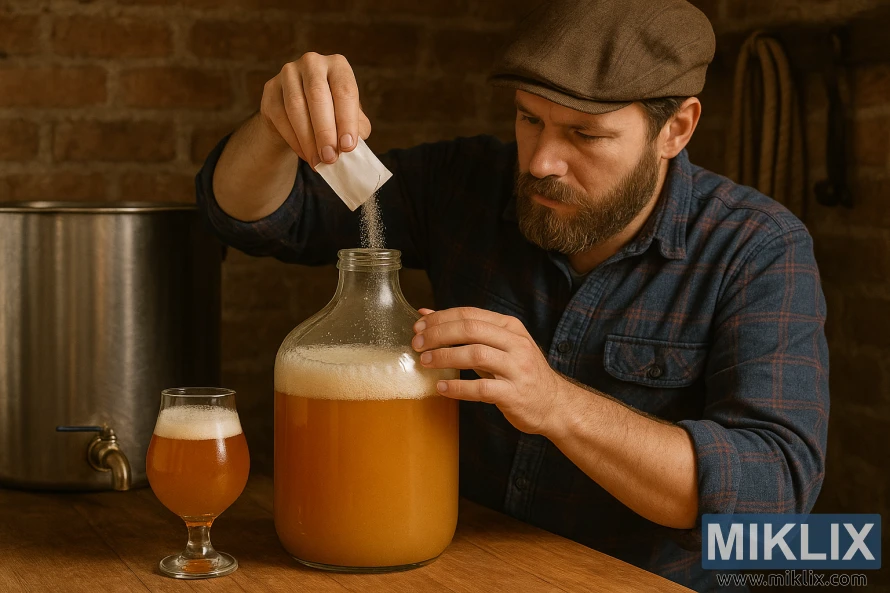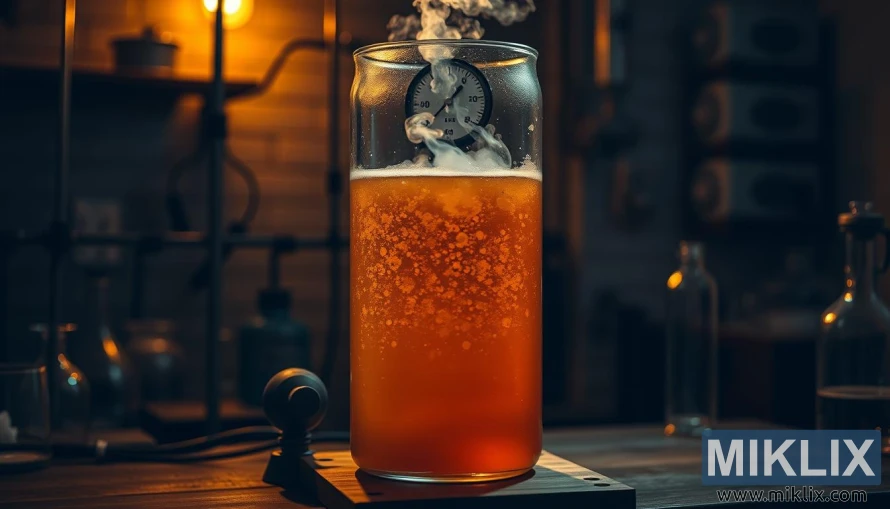Fermenting Beer with Fermentis SafAle BE-134 Yeast
Published: August 11, 2025 at 9:13:36 AM UTC
Last updated: November 27, 2025 at 4:29:14 PM UTC
Fermentis SafAle BE-134 Yeast is a dry brewing yeast, crafted by Fermentis for beers that are highly attenuated, crisp, and aromatic. It's marketed as BE-134 Saison yeast, perfect for Belgian Saison and many modern ales. It brings fruity, floral, and mildly phenolic notes to the brew.

Fermentis SafAle BE-134 Yeast is a dry brewing yeast, crafted by Fermentis for beers that are highly attenuated, crisp, and aromatic. It's marketed as BE-134 Saison yeast, perfect for Belgian Saison and many modern ales. It brings fruity, floral, and mildly phenolic notes to the brew. The yeast strain is Saccharomyces cerevisiae var. diastaticus, and it includes an emulsifier (E491) for stability in various pack sizes from 11.5 g to 10 kg.
Fermentis BE-134 benefits from Lesaffre’s quality controls and E2U™ technology. This allows brewers to pitch it directly or rehydrate it, depending on their preference. This article is a guide for U.S. homebrewers on how to select, pitch, and manage BE-134 Saison yeast. It offers practical tips for achieving clean, dry finishes and consistent fermentation performance with this exceptional dry brewing yeast.
Key Takeaways
- Fermentis SafAle BE-134 Yeast is ideal for dry, highly attenuated beers like Saison.
- The strain is Saccharomyces cerevisiae var. diastaticus and includes emulsifier E491.
- Available in multiple pack sizes from 11.5 g up to 10 kg for hobby and pro use.
- E2U™ production allows flexibility for direct pitching or rehydration.
- This guide helps U.S. homebrewers use Fermentis BE-134 safely and creatively.
What is Fermentis SafAle BE-134 Yeast and why brewers choose it
Fermentis SafAle BE-134 is a dry yeast strain, known for its high attenuation. It's favored for drying out wort while preserving complex aromas. This strain is ideal for Belgian-Saison recipes and modern ale experiments, providing a dry finish.
Its flavor profile is fruity and phenolic. Expect notes of ethyl acetate, ethyl butanoate, isoamyl acetate, and ethyl hexanoate. These are complemented by a clove-like flavor from 4-vinyl guaiacol. Medium higher alcohols and balanced esters enhance depth without overpowering hop flavors.
BE-134 is versatile, suitable for traditional Saisons and innovative ales. It excels in dry-hopped Saisons, spiced versions, and creative brews. Its strong attenuation and reliable diacetyl reduction during maturation make it a favorite among brewers.
- Performance: known for high apparent attenuation and stable fermentation.
- Aroma: strong fruity and phenolic contributions that complement citrus and spice.
- Practicality: sold as a dry yeast with E2U™ handling options for consistent results.
- Versatility: fits Belgian-Saison and many other styles seeking dryness.
SafAle BE-134's characteristics reflect Lesaffre’s commitment to quality and innovation. As part of the Fermentis SafAle range, it benefits from extensive commercial testing and ongoing R&D. Its unique fruity and phenolic traits, combined with dry yeast advantages, make it a top choice for brewers seeking clarity and a crisp finish.
Understanding apparent attenuation and alcohol tolerance of BE-134
Fermentis reports an apparent attenuation of 89-93% for BE-134. This indicates a significant consumption of sugars, leading to a very dry final gravity in most worts. Brewers aiming for a lean, crisp finish often choose this strain. They seek predictable attenuation and a drier profile than typical ale yeasts offer.
The high attenuation is due to Saccharomyces cerevisiae var. diastaticus. BE-134 secretes enzymes like amyloglucosidase. These enzymes break down complex dextrins into fermentable glucose. This capability allows the yeast to ferment sugars that other strains cannot.
BE-134 is noted for its good alcohol tolerance. It performs well across normal ale ABV ranges. It can even push apparent ethanol levels higher by fermenting more residual sugars. Brewers should refer to the technical datasheet for precise trial limits when planning high-gravity beers.
The practical implications are clear. Expect lower final gravities and higher ABV for the same original gravity compared to many ale strains. Adjust priming and packaging plans to avoid over-pressurization in bottles or kegs when using BE-134.
- Plan recipes with the listed BE-134 attenuation in mind.
- Monitor FG closely; diastaticus attenuation can continue slowly after primary activity declines.
- Control fermentation conditions to ensure the advertised apparent attenuation 89-93% is achieved reliably.
Fermentis tests guarantee at least ~89% attenuation under recommended conditions. The time to reach this level varies with temperature, pitching rate, and original gravity. It's important to watch gravity readings closely. This ensures fermentation is complete, regardless of set timelines.
Fermentation temperature ranges and aroma control
Fermentis suggests an optimal range of 18–26°C (64.4–78.8°F) for fermentation. Yet, trials have expanded this range to 64-82°F, impacting both speed and aroma. The BE-134 fermentation temperature is critical in determining yeast activity and volatile production.
Cool temperatures, near 16°C (61°F), slow down fermentation. Below 16°C, the process can take over 20 days at 54°F. Brewers aiming for a subtle ester profile and a restrained body often opt for these lower temperatures to minimize fruitiness.
Warmer temperatures, around 24°C (75°F), accelerate fermentation. A 16°P/1.065 wort can reach expected attenuation in about seven days. Saison yeast thrives in mid to high temperatures, producing tropical and stone fruit esters while reducing lag and peak activity.
Temperature also influences the production of phenolics and sulfur compounds. Ester expression increases above 20°C (68°F). Moving towards 75°F enhances banana and apple notes and increases 4-VG phenolics. Staying below 82°F is essential to avoid sulfur notes.
Temperature acts as a key factor in controlling BE-134's aroma. For a subtle fruit and clean profile, use cooler temperatures. For more pronounced spice and ester complexity, opt for mid to upper temperatures, accepting a bit more phenolic character.
- Cool (64–68°F): restrained esters, slower kinetics.
- Mid (69–75°F): fuller tropical and stone fruit esters, moderate phenolics.
- Warm (76–82°F): bold esters and phenolics, watch for sulfur at the top end.
Remember, pitching rate and original gravity influence volatile formation. Higher pitches or lower gravities can reduce ester levels. Consistent temperature control during active fermentation is key to achieving predictable results with BE-134 fermentation temperature and Saison yeast temperatures in your recipes.
Pitching rates, direct pitching and rehydration options
Fermentis suggests a 50-80 g/hl dosage for most ales with BE-134. This dosage ensures a robust cell count. It also supports steady attenuation between 18–26°C (64.4–78.8°F).
Direct pitching BE-134 is facilitated by E2U™ formulation. Sprinkle the yeast progressively across the wort surface while filling the fermenter. This method avoids clumps. Adding early helps the yeast hydrate evenly as the wort cools or adjusts toward target fermentation temperature.
For brewers who prefer to revive cells before pitching, rehydration instructions are available. Sprinkle the dry yeast into at least ten times its weight of sterile water or cooled boiled-and-hopped wort. Hold the mixture at 25–29°C (77–84°F). Rest for 15–30 minutes, then stir gently to form a creamy slurry. Pitch the slurry.
Choose the method that best fits your process and wort gravity. Direct pitching BE-134 is convenient and effective for standard-strength beers. For high-gravity worts, use rehydration instructions. This reduces osmotic shock and improves early fermentation vigor.
- Target dosage: 50-80 g/hl dosage for most fermentations.
- Direct pitching BE-134: sprinkle progressively during filling; no pre-hydration required.
- Rehydration instructions: 10× weight water, 25–29°C, rest 15–30 minutes, gentle stir, pitch cream.
Viability exceeds 1.0 x 10^10 cfu/g and purity is >99.9%. These meet EBC and ASBC microbiological limits. Match your pitching choice to wort strength, equipment, and timeline for consistent results with BE-134.

Diastaticus character: implications of var. diastaticus for homebrewers
Fermentis SafAle BE-134 is a notable example of Saccharomyces cerevisiae var. diastaticus. This strain secretes the AMG enzyme, which breaks down dextrins into fermentable sugars. Homebrewers will see extra attenuation because the yeast accesses sugars ordinary strains cannot.
The extra fermentable sugars lead to very high apparent attenuation, often above 90 percent. Expect a drier mouthfeel and modified aromatics that come with extended sugar conversion. Low flocculation means the yeast stays in suspension longer and can finish slowly.
- Monitor final gravity closely; conditioning may continue in bottles or kegs.
- Allow extra time for clarification; filtration or fining may be needed.
- Adjust mash or recipe if you want more body after attenuation.
Cross-contamination risk is real with diastaticus BE-134. The strain can continue fermenting residual sugars if it reaches other beers, barrels, or equipment. Rigid sanitation and equipment segregation reduce the chance of unintended secondary fermentations.
Plan brewery practices around the strain’s behavior. Treat Saccharomyces cerevisiae var. diastaticus like an active, persistent organism: isolate fermenters, track FG until stable, and clean with products proven to inactivate wild yeasts. These steps help avoid beer stability issues across other batches.
Packaging requires caution. Because the AMG enzyme allows further sugar conversion after filling, priming and keg sugar levels must be calculated with care. If you cannot fully control residual sugars, consider pasteurization, refrigeration, or non-fermentable priming to reduce the risk of over-carbonation and beer stability issues.
Wort composition and recipe tips for BE-134
Design a Saison grist that favors a neutral, dry backbone. Start with Pilsner or pale malt as the base. Add small amounts of wheat, rye, spelt, or oats to give spice and body without masking yeast character.
Plan the malt bill for BE-134 to leave room for yeast-driven aromatics. Use 70–85% base malt, 5–15% specialty grains, and 5–10% flaked adjuncts when you want extra mouthfeel. Keep crystal malts low to avoid sweetness that fights the strain’s high attenuation.
- For a classic Saison: Pilsner malt + 10% wheat + 5% rye.
- For a fuller mouthfeel: Pilsner + 5% oats + 5% spelt.
- For a dry, crushable beer: maximize base malt and minimize Caramel/Crystal.
Adjuncts for high attenuation work well with BE-134. Simple sugars like cane sugar, dextrose, or honey boost ABV while thinning body. Remember that the diastatic activity in this strain will further reduce dextrins, so expect a lower final gravity than with other yeasts.
When using adjuncts for high attenuation, add no more than 10–20% of fermentables as simple sugars for balance. For stronger beers, stagger sugar additions during the boil to avoid excessive hop aroma loss and to control fermentability.
Mash temperature will shape final dryness. A 148–152°F (64–67°C) saccharification rest yields a fairly fermentable wort. Raise mash to 154–156°F (68–69°C) if you want to preserve more dextrins and blunt extreme dryness from the strain.
Wort strength guidance: target 1.045–1.065 OG for balanced saisons. At these ranges, BE-134 produces very dry, drinkable beers. For high-gravity saisons, expect the yeast’s enzymatic activity to push attenuation higher; monitor fermentation to avoid stress-related phenolics.
Hop choices should complement the spice and ester profile. Use Continental European hops for traditional character. Dry hopping can add citrus and floral notes that pair with yeast esters. Light additions of herbs, flowers, or peppercorns can enhance the saison style without overwhelming it.
Water profile and oxygenation remain straightforward. Aim for moderate mineral content with a slight sulfate presence to accentuate dryness. Provide typical ale-level oxygenation before pitching to ensure healthy, vigorous fermentation.
Summary recipe pointers: keep the Saison grist simple and neutral, craft the malt bill for BE-134 to allow yeast expression, use adjuncts for high attenuation sparingly, and choose mash temps to control final body. These BE-134 recipe tips help brewers create lively, dry saisons that showcase yeast character.
Fermentation management and timeline expectations
Creating a flexible BE-134 fermentation timeline is essential. It should align with your desired temperature and original gravity. At around 75°F (24°C) and an OG of 1.065, primary fermentation typically concludes in about seven days. If you ferment at cooler temperatures, near or below 61°F (16°C), expect a longer fermentation period, often exceeding twenty days.
Begin by taking daily gravity readings, then gradually increase the interval as readings stabilize. It's important to confirm the BE-134 fermentation timeline through multiple stable final gravity (FG) readings over two or three days before packaging. This strain's ability to break down dextrins means a single low gravity reading may not confirm full attenuation.
- Rapid start, strong attenuation: vigorous early activity, then a longer finish due to low flocculation.
- Low flocculation: yeast remains in suspension and can keep working at cooler or warmer temps.
- Diacetyl handling: the strain reduces diacetyl well, but allow time in contact with yeast for cleanup if needed.
Adopt the Saison fermentation schedule for Saison-style beers. It involves a warm, active primary phase followed by a cooler conditioning period to refine flavors. If you aim for a warm primary and then cool crash, expect improved clarity. Yet, residual enzymatic activity may persist at elevated cellar temperatures.
Effective BE-134 fermentation management requires cautious packaging targets. Verify FG stability over several days. Allow additional time for conditioning, filtration, or cold resting to achieve desired clarity. When incorporating fruit or adjuncts, plan for a secondary or extended finishing phase to prevent bottle or keg refermentation.
- Warm primary (72–76°F / 22–24°C): fast attenuation, plan ~7–10 days before checking FG stability.
- Cool primary (≤61°F / ≤16°C): slow attenuation, prepare for >20 days and more frequent gravity checks.
- Conditioning: cold crash and 1–3 weeks of maturation for clarity; longer if low sedimentation is an issue.
Keep detailed records of temperatures and gravity readings for each batch. This will help refine your BE-134 fermentation timeline over time. Accurate records are key to tailoring the Saison fermentation schedule and improving fermentation management BE-134 for consistent results.
Sanitation, storage and shelf life of BE-134 dry yeast
Ensure sachets remain cool and dry to preserve their viability. SafAle BE-134 retains its potency for 36 months from production, provided it's stored correctly. Always verify the best-before date on the sachet before application.
To extend storage life, keep the yeast below 24°C for less than six months. For longer storage, aim for temperatures under 15°C. Brief temperature fluctuations up to seven days are tolerable during transport or handling.
After opening, adhere strictly to the guidelines for opened sachets. Reseal the package, store it at 4°C (39°F), and consume within seven days. Discard any sachets that appear soft, swollen, or damaged to prevent contamination or reduced viability.
Fermentis ensures high microbial quality in BE-134. The yeast count exceeds 1.0 × 10^10 cfu/g, with purity above 99.9%. The product meets EBC and ASBC standards for lactic acid bacteria, acetic bacteria, Pediococcus, wild yeasts, and total bacteria.
Sanitize all equipment thoroughly when using this strain. Clean kettles, fermenters, and drains to prevent contamination of future brews. Handle spent yeast, trub, and waste with care to avoid accidental contamination of other batches.
- Check best-before date before pitching.
- Follow opened sachet instructions: reseal, refrigerate, use within seven days.
- Store long-term below 15°C; short-term below 24°C.
- Discard damaged packaging.
- Sanitize and isolate equipment after use to limit cross-contamination.
Troubleshooting common issues when using BE-134
Stalled or slow fermentations often signal the need for BE-134 troubleshooting. Temperature is a key factor in Saison yeast issues. If the wort temperature is below 61°F, fermentation may slow down. Ensure the temperature is within the recommended range and check oxygen and nutrient levels before pitching.
When fermentation appears stuck, measure the gravity over two days. A steady reading indicates that BE-134 fermentation has stalled. Gently increase the fermenter temperature and swirl to resuspend the yeast. Avoid aggressive aeration to prevent oxidation.
Unexpected sulfur notes can be alarming for brewers. Sulphur notes in BE-134 often occur when fermentation is too hot or krausen is poor. Keep temperatures below 82°F and ensure good ventilation during fermentation to minimize sulphury off-flavors.
BE-134's diastaticus trait leads to high attenuation. Over-attenuation can surprise brewers if recipes don't account for extra dextrin breakdown. Lower mash temperatures or add dextrin malts like CaraMunich to retain body for a fuller mouthfeel.
- Clarity and haze issues: low flocculation means yeast stays in suspension.
- Countermeasures: extended conditioning, cold crash, finings, or filtration improve clarity.
- Bottle conditioning risk: because BE-134 can ferment residual dextrins, priming requires caution.
For bottle-conditioned beers, verify a stable final gravity before priming. If FG remains low, consider kegging and force-carbonating or use careful pasteurization to avoid overcarbonation. These steps reduce the chance of bottle bombs.
Cross-contamination can spread diastaticus to other beers. If unexpected continued fermentation appears in separate batches, review sanitation and segregation practices. Clean fermenters, racking gear, and hoses with proven products such as Star San or PBW to limit contamination.
Use this practical BE-134 troubleshooting checklist to guide quick fixes: confirm temperature, check oxygen and nutrients, monitor gravity trends, plan for higher attenuation in recipes, and adopt strict cleaning routines to prevent Saison yeast issues from affecting other brews.

Packaging and carbonation considerations for high-attenuation beers
Before packaging, confirm the terminal gravity. Take at least three readings over 48 to 72 hours to ensure stability. Active glucoamylase from diastaticus strains can continue to attenuate even after fermentation appears complete.
For bottle conditioning diastaticus beers, use conservative priming rates. Aim low with sugar to avoid overcarbonation due to residual enzyme activity. Test a small pilot batch first to gauge results.
For precise control, consider kegging BE-134 and force carbonation. Kegging allows for quick CO2 volume adjustments, preventing pressure spikes in glass bottles with ongoing fermentation.
Clarify the beer before packaging to lower yeast counts. Extended cold conditioning, filtration, or time for flocculation benefits BE-134 packaging. Fewer suspended cells reduce the risk of late fermentation in sealed containers.
- Use robust bottles rated for higher CO2 pressure if you choose bottle conditioning.
- Cold crash and store at near-freezing temperatures after packaging to slow enzymatic activity.
- Consider pasteurization only after careful risk assessment; it can stop residual fermentation but adds processing steps.
Label and document processing steps when distributing beers made with diastaticus strains. Note the priming sugar BE-134 choices, stabilization methods, and any pasteurization or filtration performed. Clear labeling supports safety and regulatory transparency.
When planning bulk packaging, rate containers for expected CO2 and temperature. Kegging BE-134 reduces bottle breakage risk and simplifies achieving stable carbonation. Maintain cold storage and monitor pressure for at least a week after packaging.
In every case, match your priming sugar BE-134 approach to beer style and risk tolerance. Conservative priming plus cold conditioning offers the safest path for high-attenuation beers fermented with BE-134 packaging variables in mind.
Comparing BE-134 to other SafAle strains
Fermentis highlights BE-134 as the top choice for dry, spicy Belgian beers. In a comparison of SafAle strains, BE-134 excels with higher attenuation and clear enzymatic activity. It also boasts bold ester and phenolic flavors.
When comparing S-04 and BE-134, the differences are clear. S-04 offers a cleaner, more neutral taste with better flocculation for clearer beer. On the other hand, BE-134 retains more yeast-derived aromas and pushes dryness further.
Looking at T-58 and BE-134, the phenolic intensity is a key factor. T-58 provides classic Belgian spice without diastaticus activity. BE-134, while similar in phenolics, can ferment more dextrins, affecting body and final gravity.
- Use-case guidance: pick BE-134 when dryness and bold yeast character are goals.
- Choose S-04 or US-05 when clarity or a neutral ester balance is preferred.
- Choose T-58 when you want phenolics without the diastaticus risks.
Fermentation handling varies among strains. BE-134 demands strict measures against cross-contamination due to its diastaticus trait. Non-diastaticus SafAle strains require less containment but benefit from standard sanitation.
A brief comparison of SafAle strains aids brewers in aligning yeast with their recipe goals. Consider the desired attenuation, esters, and phenolics, as well as post-fermentation handling. This will help in deciding between S-04 vs BE-134 or T-58 vs BE-134.
Safety and regulatory notes for homebrewers using diastaticus strains
Fermentis adheres to rigorous hygiene and microbiological standards in production. This ensures that yeast meets stringent criteria for pathogenic organisms. Lesaffre and other manufacturers document their cellar practices and batch testing. This aligns with the expectations for food safety yeast.
Homebrewers must prioritize sanitation. Good sanitation involves cleaning and sanitizing fermenters, racking lines, bottles, and kegging gear after a diastaticus run. This prevents cross-contamination. Even small residues of active yeast can restart fermentation in later batches.
Equipment segregation is also key. Many hobbyists dedicate one fermenter or set of fittings for diastaticus beers. Others create a written log of runs and sanitation steps. This approach lowers the risk to other beers and reduces the chance of accidental over-attenuation.
When packaging, prioritize consumer safety. Verify the final gravity before bottling to reduce pressure risk. For distribution, kegging with force carbonation or pasteurization provides more control. This aligns with best practices for food safety yeast handling.
If sharing or selling beer, labeling is essential. Clear disclosure that a diastaticus strain was used is necessary. Notes on conditioning or storage allow retailers and consumers to store and serve safely. This meets common regulatory notes BE-134 for transparency.
- Follow documented cleaning protocols after diastaticus batches.
- Verify terminal gravity before priming or bottling.
- Use dedicated equipment or thorough logs to prevent cross-contamination.
- Label beers that used diastaticus strains when distributing.

Recipe examples and experimental ideas with BE-134
Begin with a traditional Saison recipe BE-134: 85–90% pale pilsner or pale ale malt, 10–15% wheat, spelt, or rye, and an original gravity of 1.048–1.060. Mash at 145–151°F for a moderate body. Rely on BE-134 to achieve the final dryness. Use continental hops at modest rates to balance bitterness. Let the yeast bring out fruity and peppery notes.
For a modern, high-attenuation saison, add 5–15% simple sugar or honey to increase dryness and ABV. Mash at the same moderate range. Raise fermentation to 72–76°F to enhance esters and phenolics. Monitor final gravity closely. These BE-134 recipes are key to achieving a soft finish or a razor-dry profile.
Explore fruit saisons BE-134 by adding fruit after primary fermentation or during conditioning. Stone fruit, citrus, and berries complement the strain’s esters. Consider extra fermentables and the risk of refermentation. Measure gravity before packaging and consider pasteurization or kegging to prevent overcarbonation.
Hybrid concepts are worth trying: pair BE-134 with bold dry hopping for a dry-hopped Saison, or blend it with darker specialty malts for a spicier, amber version. Lower mash temperatures increase fermentability. Small additions of invert or dextrin syrup help control body without sacrificing dryness.
- Small-batch trials: split batches to compare 68°F vs 75°F fermentation and note flavor shifts.
- Adjunct timing: add fruit in secondary versus conditioning to tune aroma intensity.
- Packaging tests: prime in-bottle, keg force-carbonate, and cold-crash to see which preserves desired character.
Keep detailed notes on each test. Fermentis advises trialing strains under your brewery conditions before scaling. Use these experimental beers BE-134 ideas to refine recipes. Build a catalog of proven Saison recipe BE-134 variations for future brews.
Resources, technical data and further reading
Begin with the official Fermentis BE-134 TDS to verify details like viability and recommended dosage. The technical data sheet provides exact figures for planning your experiments or production batches.
Examine Fermentis studies for insights into BE-134's performance. A fermentation study details attenuation levels, ester and phenolic compounds, and kinetics across various temperatures. This information helps set realistic expectations for attenuation and flavor.
Explore Lesaffre Fermentis resources for a broader understanding of their products. Their product pages compare SafAle strains and list related options like S-04, T-58, and US-05. This context helps position BE-134 within a range of strains and aids in selecting alternatives for split-batch tests.
Consult industry standards for lab work. EBC Analytica and ASBC Microbiological Control methods are endorsed by manufacturers. They serve as a foundation for testing and quality assurance when working with diastaticus strains.
- Download the Fermentis BE-134 TDS for analytical values and trial parameters.
- Request manufacturer data on kinetics and sensory matrices when planning a pilot.
- Use peer-reviewed brewing literature for deeper insight into Saccharomyces cerevisiae var. diastaticus.
Utilize community reports for practical insights. Homebrew forums and Beer & Brewing split-batch tests often reveal real-world behaviors not detailed in lab sheets. View these reports as additional information to the BE-134 technical data sheet and Fermentis guidance.
Keep detailed records during experiments. Compare your findings with the Fermentis BE-134 TDS and recorded fermentation study outcomes. This ensures reproducibility and safe handling in production.

Conclusion
Fermentis SafAle BE-134 Yeast conclusion: BE-134 stands out as a robust, adaptable dry yeast for brewers targeting high attenuation and a crisp finish. Its ability to produce distinct fruity and phenolic aromas makes it perfect for Saison-style beers and other recipes that benefit from spicy esters. When brewing with BE-134, anticipate a lean final gravity and a lively character, provided fermentation is managed with care.
Key operational takeaways include using the recommended dosages (50–80 g/hl), maintaining fermentation temperatures between 64–76°F to shape aromas, and ensuring final gravity stability before packaging. Proper sanitation and correct storage are essential to reduce cross-contamination risks and preserve viability. For optimal use of BE-134, control oxygenation, pitching rate, and fermentation timeline to align with your mash profile and attenuation objectives.
The final recommendation is to conduct small-scale trials to fine-tune mash schedule, temperature, and packaging for your system. Refer to the Fermentis technical sheet and community reports to refine your approach and troubleshoot. With meticulous handling, BE-134 can become a reliable ally for brewers aiming for bold attenuation and classic Saison-like flavors.
Further Reading
If you enjoyed this post, you may also like these suggestions:
- Fermenting Beer with CellarScience Hornindal Yeast
- Fermenting Beer with Lallemand LalBrew Belle Saison Yeast
- Fermenting Beer with CellarScience English Yeast
